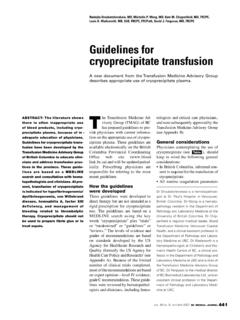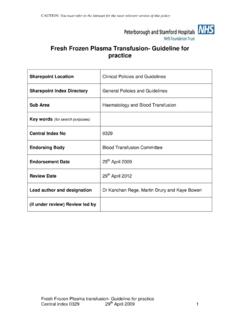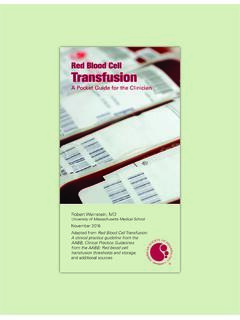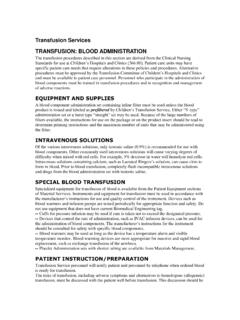Transcription of Transfusion of Blood and Blood Products: Indications and ...
1 Transfusion of Blood and Blood Products: Indications and Complications SANJEEV SHARMA, MD; POONAM SHARMA, MD; and LISA N. TYLER, MD. Creighton University School of Medicine, Omaha, Nebraska Red Blood cell transfusions are used to treat hemorrhage and to improve oxygen delivery to tissues. Transfusion of red Blood cells should be based on the patient's clinical condition. Indications for Transfusion include symptomatic anemia (causing shortness of breath, dizziness, congestive heart failure, and decreased exercise tolerance), acute sickle cell crisis, and acute Blood loss of more than 30 percent of Blood volume.
2 Fresh frozen plasma infusion can be used for reversal of anticoagulant effects. Platelet Transfusion is indicated to prevent hemorrhage in patients with thrombocytopenia or platelet function defects. Cryoprecipitate is used in cases of hypofibrinogenemia, which most often occurs in the setting of massive hemorrhage or consumptive coagulopathy. Transfusion -related infections are less common than noninfectious complications. All noninfectious complications of Transfusion are classified as noninfectious serious hazards of Transfusion . Acute complications occur within minutes to 24 hours of the Transfusion , whereas delayed complications may develop days, months, or even years later.
3 (Am Fam Physician. 2011;83(6):719-724. Copyright 2011 American Academy of Family Physicians.). B. lood Transfusion can be a life- sickle cell crisis (for stroke prevention), or saving procedure, but it has risks, acute Blood loss of greater than 1,500 mL or including infectious and nonin- 30 percent of Blood Patients with fectious complications. There is symptomatic anemia should be transfused debate in the medical literature concern- if they cannot function without treating the ing the appropriate use of Blood and Blood Symptoms of anemia may include products.
4 Clinical trials investigating their fatigue, weakness, dizziness, reduced exer- use suggest that waiting to transfuse at lower cise tolerance, shortness of breath, changes hemoglobin levels is ,2 This review in mental status, muscle cramps, and will consider the Indications for Transfusion angina or severe congestive heart failure. of Blood and Blood products, and will dis- The 10/30 rule Transfusion when a patient cuss common noninfectious complications has a hemoglobin level less than or equal to associated with Transfusion . 10 g per dL (100 g per L) and a hematocrit level less than or equal to 30 percent was Red Blood Cells used until the 1980s as the trigger to trans- Packed red Blood cells (RBCs) are prepared fuse, regardless of the patient's clinical from whole Blood by removing approxi- ,5.
5 Mately 250 mL of plasma. One unit of packed In 1999, a randomized, multicenter, con- RBCs should increase levels of hemoglobin trolled clinical trial evaluated a restrictive by 1 g per dL (10 g per L) and hematocrit by Transfusion trigger (hemoglobin level of 7 to 3 percent. In most areas, packed RBC units 9 g per dL [70 to 90 g per L]) versus a lib- are filtered to reduce leukocytes before eral Transfusion trigger (hemoglobin level storage, which limits febrile nonhemolytic of 10 to 12 g per dL [100 to 120 g per L]). Transfusion reactions (FNHTRs), and are in patients who were critically Restric- considered cytomegalovirus tive Transfusion practices resulted in a 54.
6 RBC transfusions are used to treat hemor- percent relative decrease in the number rhage and to improve oxygen delivery to tis- of units transfused and a reduction in the sues. Transfusion of RBCs should be based 30-day mortality rate. The authors recom- on the patient's clinical Indi- mended Transfusion when hemoglobin is cations for RBC Transfusion include acute less than 7 g per dL, and maintenance of a Downloaded from the American Family Physician Web site at Copyright 2011 American Academy of Family Physicians. For the private, noncommercial March 15, 2011 Volume 83, Number 6.
7 Use of one individual user of the Web site. All other rights reserved.. Contact American for copyright questions and/or permission Physician 719. Family requests. SORT: KEY RECOMMENDATIONS FOR PRACTICE. Evidence Clinical recommendation rating References Comments The threshold for Transfusion of red Blood cells should be a hemoglobin A 1, 2, 6 RCTs in adults and level of 7 g per dL (70 g per L) in adults and most children. children with a critical illness A restrictive Transfusion strategy (hemoglobin level of 7 to 9 g per dL B 2 RCT in children with a [70 to 90 g per L]) should not be used in preterm infants or children critical illness with cyanotic heart disease, severe hypoxemia, active Blood loss, or hemodynamic instability.
8 Transfusion of plasma should be considered in a patient who has an C 8 Consensus conference International Normalized Ratio greater than with active bleeding, or recommendations in a patient receiving anticoagulant therapy before an invasive procedure. Platelets should not be transfused in patients with thrombotic C 10, 11 Guidelines based on case thrombocytopenic purpura or heparin-induced thrombocytopenia reports unless a life-threatening hemorrhage has occurred. RCT = randomized controlled trial. A = consistent, good-quality patient-oriented evidence; B = inconsistent or limited-quality patient-oriented evidence; C = consensus, disease- oriented evidence, usual practice, expert opinion, or case series.
9 For information about the SORT evidence rating system, go to hemoglobin level between 7 to 9 g per A recently per dL (85 to 95 g per L). The liberal Transfusion trig- updated Cochrane review supports the use of restrictive ger was a hemoglobin level of g per dL, with a target Transfusion triggers in patients who do not have cardiac level of 11 to 12 g per dL (110 to 120 g per L). Patients in the restrictive group received 44 percent fewer Blood A similar study was carried out in critically ill chil- transfusions, with no difference in rates of multiple organ The restrictive Transfusion trigger was a hemoglo- dysfunction syndrome or death.
10 The restrictive transfu- bin level of 7 g per dL, with a target level of to g sion strategy is useful for children who are stable patients in intensive care. It should not be used in preterm neonates or in children with severe Table 1. Indications for Transfusion of Plasma Products hypoxemia, active Blood loss, hemodynamic instability, or cyanotic heart Indication Associated condition/additional information Plasma International Normalized Inherited deficiency of single clotting factors Plasma products available in the United Ratio > with no virus-safe or recombinant factor States include fresh frozen plasma and available anticoagulant factors II, V, X, or XI.
















